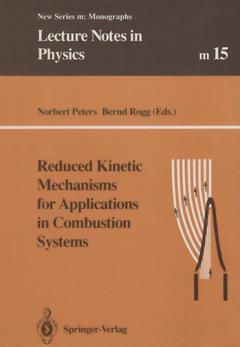Reduced Kinetic Mechanisms for Applications in Combustion Systems, Softcover reprint of the original 1st ed. 1993 Lecture Notes in Physics Monographs Series, Vol. 15
Langue : Anglais
Coordonnateurs : Peters Norbert, Rogg Bernd

In general, combustion is a spatially three-dimensional, highly complex physi co-chemical process oftransient nature. Models are therefore needed that sim to such a degree that it becomes amenable plify a given combustion problem to theoretical or numerical analysis but that are not so restrictive as to distort the underlying physics or chemistry. In particular, in view of worldwide efforts to conserve energy and to control pollutant formation, models of combustion chemistry are needed that are sufficiently accurate to allow confident predic tions of flame structures. Reduced kinetic mechanisms, which are the topic of the present book, represent such combustion-chemistry models. Historically combustion chemistry was first described as a global one-step reaction in which fuel and oxidizer react to form a single product. Even when detailed mechanisms ofelementary reactions became available, empirical one step kinetic approximations were needed in order to make problems amenable to theoretical analysis. This situation began to change inthe early 1970s when computing facilities became more powerful and more widely available, thereby facilitating numerical analysis of relatively simple combustion problems, typi cally steady one-dimensional flames, with moderately detailed mechanisms of elementary reactions. However, even on the fastest and most powerful com puters available today, numerical simulations of, say, laminar, steady, three dimensional reacting flows with reasonably detailed and hence realistic ki netic mechanisms of elementary reactions are not possible.
Fundamentals.- Flame Calculations with Reduced Mechanisms — An Outline.- A Compilation of Experimental Data on Laminar Burning Velocities.- Unstretched Premixed Flames.- Reduced Kinetic Mechanisms for Premixed Hydrogen Flames.- Reduced Kinetic Mechanisms for Wet CO Flames.- Reduced Kinetic Mechanisms for Premixed Methane-Air Flames.- Premixed Ethylene/Air and Ethane/Air Flames: Reduced Mechanisms Based on Inner Iteration.- Reduced Kinetic Mechanisms for Premixed Acetylene-Air Flames.- Reduced Kinetic Mechanisms for Premixed Propane-Air Flames.- Reduced Kinetic Mechanisms for Premixed Methanol Flames.- Counterflow Diffusion Flames.- Structure and Extinction of Non-Diluted Hydrogen-Air Diffusion Flames.- Structure and Extinction of Hydrogen-Air Diffusion Flames.- CO-HP2-N2/Air Diffusion Flames: Thermal Radiation and Transient Effects.- Reduced Kinetic Mechanisms for Counterflow Methane-Air Diffusion Flames.- Reduced Kinetic Mechanisms for Acetylene Diffusion Flames.- Reduced Kinetic Mechanisms for Propane Diffusion Flames.- Reduced Kinetic Mechanisms for Counterflow Methanol Diffusion Flames.- Reduced Kinetic Mechanisms and NOx Formation in Diffusion Flames of CH4/C2H6 Mixtures.
Date de parution : 11-2013
Ouvrage de 362 p.
17x24.4 cm
Disponible chez l'éditeur (délai d'approvisionnement : 15 jours).
Prix indicatif 105,49 €
Ajouter au panierThème de Reduced Kinetic Mechanisms for Applications in... :
© 2024 LAVOISIER S.A.S.



